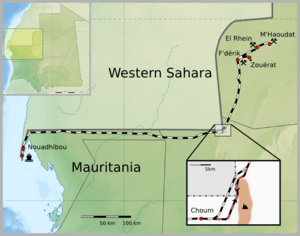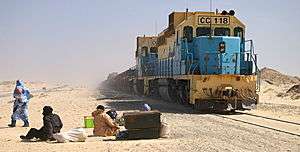Mauritania Railway
| Mauritania Railway | |||||||||||||||||||||||||||||||||||||||||||||||||||||||||||||||||||||||||||||||||||||||||||||||||||||||||||||||||||||||||||||||||||||||||||||||||
|---|---|---|---|---|---|---|---|---|---|---|---|---|---|---|---|---|---|---|---|---|---|---|---|---|---|---|---|---|---|---|---|---|---|---|---|---|---|---|---|---|---|---|---|---|---|---|---|---|---|---|---|---|---|---|---|---|---|---|---|---|---|---|---|---|---|---|---|---|---|---|---|---|---|---|---|---|---|---|---|---|---|---|---|---|---|---|---|---|---|---|---|---|---|---|---|---|---|---|---|---|---|---|---|---|---|---|---|---|---|---|---|---|---|---|---|---|---|---|---|---|---|---|---|---|---|---|---|---|---|---|---|---|---|---|---|---|---|---|---|---|---|---|---|---|---|
 Map of Mauritania Railway | |||||||||||||||||||||||||||||||||||||||||||||||||||||||||||||||||||||||||||||||||||||||||||||||||||||||||||||||||||||||||||||||||||||||||||||||||
| Line length: | 704 km (437 mi) | ||||||||||||||||||||||||||||||||||||||||||||||||||||||||||||||||||||||||||||||||||||||||||||||||||||||||||||||||||||||||||||||||||||||||||||||||
| Track gauge: | 1,435 mm (4 ft 8 1⁄2 in) standard gauge | ||||||||||||||||||||||||||||||||||||||||||||||||||||||||||||||||||||||||||||||||||||||||||||||||||||||||||||||||||||||||||||||||||||||||||||||||
Legend
| |||||||||||||||||||||||||||||||||||||||||||||||||||||||||||||||||||||||||||||||||||||||||||||||||||||||||||||||||||||||||||||||||||||||||||||||||
The Mauritania Railway is the national railway of Mauritania. Opened in 1963,[1] it consists of a single, 704-kilometre (437 mi) railway line linking the iron mining centre of Zouerate with the port of Nouadhibou, via Fderik and Choum. The state agency Société Nationale Industrielle et Minière (National Mining and Industrial Company, SNIM) controls the railway line.
Since the closure of the Choum Tunnel, a 5 km (3.1 mi) section of the railway cuts through the Polisario Front-controlled part of the Western Sahara (21°21′18″N 13°00′46″W / 21.354867°N 13.012644°W).
History
Traffic

Trains on the railway are up to 2.5 kilometres (1.6 mi) in length,[2] making them among the longest and heaviest in the world. They consist of 3 or 4 diesel-electric EMD locomotives, 200 to 210 cars each carrying up to 84 tons of iron ore, and a variable number of service cars. The total traffic averages 16.6 million tons per year.
Passengers are also occasionally transported by train; these services are managed by an SNIM subsidiary, the ATTM Society (Société d'assainissement, de travaux, de transport et de maintenance). Passenger cars are sometimes attached, but more often passengers simply ride atop the ore hopper cars.
Locomotives
In October 2010, SNIM ordered a batch of six EMD SD-70ACS locomotives, with special modifications for operating in high temperatures.[3]
Glencore Xstrata
In 2014, Glencore Xstrata paid $ 1 billion to SNIM for access to that company's rail and port infrastructure. There will be branch lines to new mines at Askaf and Guelb El Aouj. It is cheaper for Glencore to share existing infrastructure than to build its own. [4]
See also
- Economy of Mauritania
- History of rail transport in Mauritania
- Transport in Mauritania
- Railway stations in Mauritania
- Enclave and exclave - crossborder shortcut to avoid tunnel
References
Notes
- ↑ "Mauritania, a Nation of Moorish Nomads, Suddenly Finds Herself in 20th Century". The New York Times. January 20, 1964.
last June, the 20th century elbowed its way into this Biblical picture
- ↑ "The ore train". Société Nationale Industrielle et Minière. Archived from the original on September 19, 2008. Retrieved December 17, 2008.
- ↑ "Railway Gazette: High temperature locomotives ordered from EMD". Retrieved 2010-10-30.
- ↑ http://www.railpage.com.au/f-t11332401.htm
Further reading
- Robinson, Neil (2009). World Rail Atlas and Historical Summary. Volume 7: North, East and Central Africa. Barnsley, UK: World Rail Atlas Ltd. ISBN 978-954-92184-3-5.
External links
| Wikimedia Commons has media related to Mauritania Railway. |